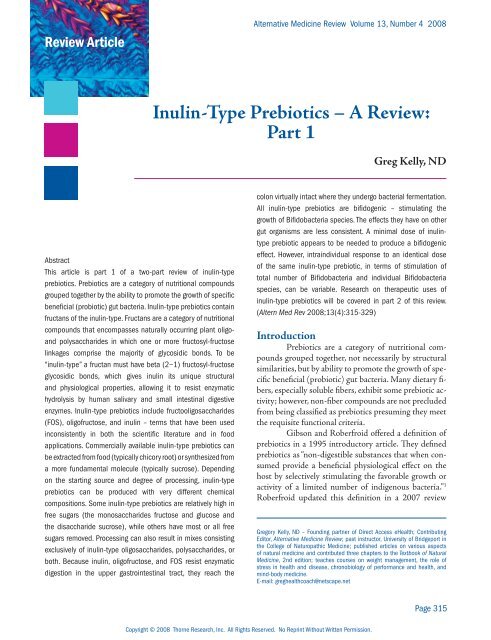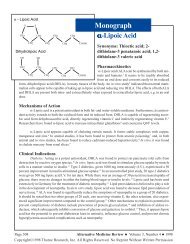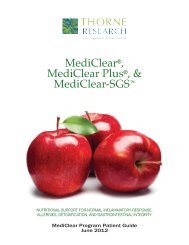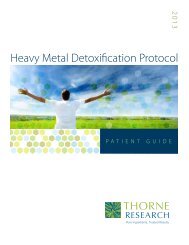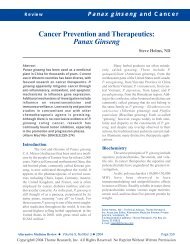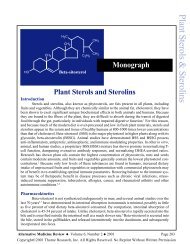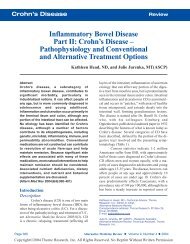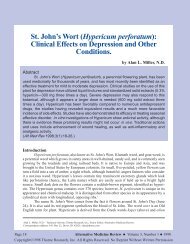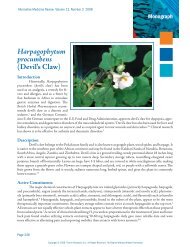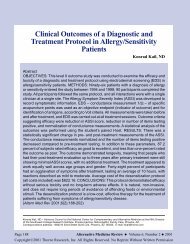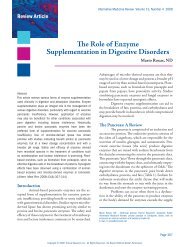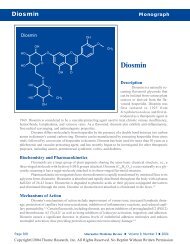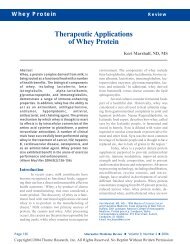Inulin-Type Prebiotics â A Review: Part 1 - Alternative Medicine ...
Inulin-Type Prebiotics â A Review: Part 1 - Alternative Medicine ...
Inulin-Type Prebiotics â A Review: Part 1 - Alternative Medicine ...
You also want an ePaper? Increase the reach of your titles
YUMPU automatically turns print PDFs into web optimized ePapers that Google loves.
<strong>Review</strong> Article<br />
<strong>Alternative</strong> <strong>Medicine</strong> <strong>Review</strong> Volume 13, Number 4 2008<br />
<strong>Inulin</strong>-<strong>Type</strong> <strong>Prebiotics</strong> – A <strong>Review</strong>:<br />
<strong>Part</strong> 1<br />
Greg Kelly, ND<br />
Abstract<br />
This article is part 1 of a two-part review of inulin-type<br />
prebiotics. <strong>Prebiotics</strong> are a category of nutritional compounds<br />
grouped together by the ability to promote the growth of specific<br />
beneficial (probiotic) gut bacteria. <strong>Inulin</strong>-type prebiotics contain<br />
fructans of the inulin-type. Fructans are a category of nutritional<br />
compounds that encompasses naturally occurring plant oligoand<br />
polysaccharides in which one or more fructosyl-fructose<br />
linkages comprise the majority of glycosidic bonds. To be<br />
“inulin-type” a fructan must have beta (2−1) fructosyl-fructose<br />
glycosidic bonds, which gives inulin its unique structural<br />
and physiological properties, allowing it to resist enzymatic<br />
hydrolysis by human salivary and small intestinal digestive<br />
enzymes. <strong>Inulin</strong>-type prebiotics include fructooligosaccharides<br />
(FOS), oligofructose, and inulin – terms that have been used<br />
inconsistently in both the scientific literature and in food<br />
applications. Commercially available inulin-type prebiotics can<br />
be extracted from food (typically chicory root) or synthesized from<br />
a more fundamental molecule (typically sucrose). Depending<br />
on the starting source and degree of processing, inulin-type<br />
prebiotics can be produced with very different chemical<br />
compositions. Some inulin-type prebiotics are relatively high in<br />
free sugars (the monosaccharides fructose and glucose and<br />
the disaccharide sucrose), while others have most or all free<br />
sugars removed. Processing can also result in mixes consisting<br />
exclusively of inulin-type oligosaccharides, polysaccharides, or<br />
both. Because inulin, oligofructose, and FOS resist enzymatic<br />
digestion in the upper gastrointestinal tract, they reach the<br />
colon virtually intact where they undergo bacterial fermentation.<br />
All inulin-type prebiotics are bifidogenic – stimulating the<br />
growth of Bifidobacteria species. The effects they have on other<br />
gut organisms are less consistent. A minimal dose of inulintype<br />
prebiotic appears to be needed to produce a bifidogenic<br />
effect. However, intraindividual response to an identical dose<br />
of the same inulin-type prebiotic, in terms of stimulation of<br />
total number of Bifidobacteria and individual Bifidobacteria<br />
species, can be variable. Research on therapeutic uses of<br />
inulin-type prebiotics will be covered in part 2 of this review.<br />
(Altern Med Rev 2008;13(4):315-329)<br />
Introduction<br />
<strong>Prebiotics</strong> are a category of nutritional compounds<br />
grouped together, not necessarily by structural<br />
similarities, but by ability to promote the growth of specific<br />
beneficial (probiotic) gut bacteria. Many dietary fibers,<br />
especially soluble fibers, exhibit some prebiotic activity;<br />
however, non-fiber compounds are not precluded<br />
from being classified as prebiotics presuming they meet<br />
the requisite functional criteria.<br />
Gibson and Roberfroid offered a definition of<br />
prebiotics in a 1995 introductory article. They defined<br />
prebiotics as “non-digestible substances that when consumed<br />
provide a beneficial physiological effect on the<br />
host by selectively stimulating the favorable growth or<br />
activity of a limited number of indigenous bacteria.” 1<br />
Roberfroid updated this definition in a 2007 review<br />
Gregory Kelly, ND – Founding partner of Direct Access eHealth; Contributing<br />
Editor, <strong>Alternative</strong> <strong>Medicine</strong> <strong>Review</strong>; past instructor, University of Bridgeport in<br />
the College of Naturopathic <strong>Medicine</strong>; published articles on various aspects<br />
of natural medicine and contributed three chapters to the Textbook of Natural<br />
<strong>Medicine</strong>, 2nd edition; teaches courses on weight management, the role of<br />
stress in health and disease, chronobiology of performance and health, and<br />
mind-body medicine.<br />
E-mail: greghealthcoach@netscape.net<br />
Page 315<br />
Copyright © 2008 Thorne Research, Inc. All Rights Reserved. No Reprint Without Written Permission.
<strong>Review</strong> Article<br />
<strong>Alternative</strong> <strong>Medicine</strong> <strong>Review</strong> Volume 13, Number 4 2008<br />
article on prebiotics: “a selectively fermented ingredient<br />
that allows specific changes, both in the composition<br />
and/or activity in the gastrointestinal microflora that<br />
confers benefits upon host well-being and health.” 2<br />
Definitions of prebiotics typically have in common<br />
an emphasis on the compound being non-digestible (and<br />
hence subject to colonic enzymatic activity and fermentation<br />
by colonic bacteria) and able to selectively stimulate<br />
the growth of one or more desirable or health-enhancing<br />
types of gut bacteria. While definitions of prebiotics do not<br />
emphasize a specific bacterial group, the number and/or<br />
activity of Bifidobacteria and other lactic acid-producing<br />
bacteria must be increased for the compound to qualify<br />
as a prebiotic. Either implicitly or explicitly within most<br />
definitions is the concept that the compound improve the<br />
health of the subject consuming it.<br />
While many nutritional compounds have<br />
some degree of prebiotic activity, Roberfroid identified<br />
two groupings of nutritional compounds that met his<br />
definition, inulin-type prebiotics and galactooligosaccharides<br />
(GOS). 2<br />
Other nutritional compounds suggested as<br />
prebiotics, but not included by Roberfroid as prebiotics,<br />
include gentiooligosaccharides, glucooligosaccharides,<br />
isomaltooligosaccharides, mannan oligosaccharides,<br />
N-acetylchitooligosaccharides, oligosaccharides from<br />
melibiose, pectic oligosaccharides, xylooligosaccharides,<br />
gums (like gum Arabic), hemicellulose-rich substrates,<br />
resistant starches (such as resistant maltodextrin),<br />
lactosucrose, oligodextrans, polydextrose, germinated<br />
barley, gluconic acid, glutamine, lactose, and the simple<br />
sugar tagatose (a mirror image of fructose). 2-5 Because<br />
research on several of these compounds for prebiotic activity<br />
is promising, it is possible that in the future one or<br />
more of these compounds might also meet the criteria<br />
specified in Roberfroid’s definition of prebiotics.<br />
This review article will focus on one of the two<br />
subcategories of prebiotics Roberfroid included in his<br />
definition – inulin-type prebiotics. This grouping was<br />
selected because they represent the most widely commercially-available<br />
prebiotic compounds. <strong>Part</strong> 1 of this review<br />
defines inulin-type prebiotics, explores food applications,<br />
and examines their ability to modulate gut microflora. In<br />
part 2, studies examining the use of inulin-type prebiotics<br />
as a therapeutic option will be reviewed.<br />
<strong>Inulin</strong>-type prebiotics include inulin, oligofructose,<br />
and fructooligosaccharides (FOS), oligo- or<br />
Figure 1. GF 2<br />
Fructan<br />
Glucose α(1–2)<br />
Fructose<br />
β(2–1)<br />
Fructose<br />
polysaccharide chains comprised primarily of linked<br />
fructose molecules that are bifidogenic. <strong>Inulin</strong>-type prebiotics<br />
are used as functional food ingredients in beverages,<br />
yogurts, biscuits, and spreads; they are also used as<br />
dietary supplements.<br />
<strong>Inulin</strong>-type prebiotic compounds are naturally<br />
occurring constituents in many plants. Root vegetables<br />
including Jerusalem artichokes, burdock, chicory, leeks,<br />
and onions are especially rich sources. Estimates suggest<br />
a person consuming an average North American diet ingests<br />
1-4 g inulin-type prebiotic compounds daily, a low<br />
daily intake compared to a less processed diet, higher in<br />
plant foods. It is also considered low compared to other<br />
regions of the world, such as Europe, where estimates<br />
suggest an average daily intake of 3-11 g. 6<br />
General Chemical Structure of <strong>Inulin</strong>type<br />
<strong>Prebiotics</strong><br />
<strong>Inulin</strong>-type prebiotics are members of a larger<br />
group called “fructans.” Fructans represent a category of<br />
compounds that encompasses all naturally occurring<br />
plant oligo- and polysaccharides in which one or more<br />
fructosyl-fructose linkages comprise the majority of<br />
glycosidic bonds; hence, they are primarily polymers of<br />
fructose units. Fructans can have at least one fructosylglucose<br />
linkage – identical to that found with sucrose<br />
and, when present, is typically a starting link in the<br />
polymer chain. When the starting molecule is sucrose in<br />
the fructan chain, the bond between the starting glucose<br />
and the second carbon (of fructose) can be hydrolyzed<br />
to some degree by sucrase enzymes, secreted by the tips<br />
of the small intestinal epithelial villi, and produce free<br />
glucose. The presence of this sucrose sugar moiety is not<br />
a necessary precondition for the compound to be considered<br />
a fructan; therefore, many fructans begin with<br />
fructose. Structurally, fructans can be linear or branched<br />
fructose polymers.<br />
Page 316<br />
Copyright © 2008 Thorne Research, Inc. All Rights Reserved. No Reprint Without Written Permission.
<strong>Alternative</strong> <strong>Medicine</strong> <strong>Review</strong> Volume 13, Number 4 2008<br />
<strong>Inulin</strong>-<strong>Type</strong> <strong>Prebiotics</strong><br />
Figure 2. F 3<br />
Fructan<br />
Fructose Fructose Fructose<br />
β(2–1) β(2–1)<br />
An individual fructan having a glucose molecule<br />
preceding fructose is designated as GF n<br />
– G referring<br />
to the terminal glucose unit, F referring to fructose<br />
units, and n designating the number of fructose units<br />
found in the fructan chain. Hence, GF 2<br />
is a fructan oligosaccharide<br />
with a terminal glucose followed by two<br />
fructose units (Figure 1). This fructan has one fructosyl-glucose<br />
linkage (a sucrose molecule) followed by one<br />
fructosyl-fructose linkage. A fructan with no glucose<br />
would be designated as either F n<br />
or F m<br />
. Both are used<br />
in the scientific literature with n (or m) referring to the<br />
number of fructose units occurring in the fructan. In<br />
this review, n will be used. A fructan designated as F 3<br />
(Figure 2) has three fructose units and two fructosylfructose<br />
linkages.<br />
Fructans can also be described by degree of<br />
polymerization (DP). DP refers to the number of repeat<br />
units in an oligomer or polymer chain, so DP of<br />
an individual fructan would be its number of repeating<br />
fructose units and identical to n.<br />
<strong>Inulin</strong> is a generic term that covers all linear<br />
fructans with beta (2−1) fructosyl-fructose glycosidic<br />
bonds. 2 This specific type of glycosidic bond gives inulin<br />
its unique structural and physiological properties.<br />
Because of the beta configuration of the bonds between<br />
fructose monomers, inulin-type fructans resist enzymatic<br />
hydrolysis by human salivary and small intestinal<br />
digestive enzymes – specific for alpha-glycosidic bonds.<br />
As a result, inulin-type fructans are indigestible and are<br />
fermented in the colon. 2<br />
General Description of Commercial<br />
<strong>Inulin</strong>-type <strong>Prebiotics</strong><br />
Although commercially available inulin-type<br />
prebiotics meet the general chemical structure needed<br />
to be called inulin-type, they are not comprised homogenously<br />
of a single type of fructan. <strong>Inulin</strong>-type prebiotics<br />
can be extracted from a food source (typically chicory<br />
root) or synthesized from a more fundamental molecule<br />
(typically sucrose). In either instance, the resultant inulin-type<br />
prebiotic consists of mixtures of inulin-type<br />
fructan molecules with varying DP. Some inulin-type<br />
fructans begin with glucose as the starting unit (GF n<br />
type fructans), while others do not include a glucose<br />
monosaccharide unit (F n<br />
type fructans). Some inulintype<br />
prebiotic products have a low proportion of glucose<br />
units, while others have far higher proportions. Within<br />
the overall mixture there might be inulin-type fructans<br />
that consist of as few as two fructose units or more than<br />
60 fructose units. Despite these variations, as long as the<br />
fructans in the product are of the inulin-type, the product<br />
is correctly classified as an inulin-type prebiotic.<br />
Commercial products comprised of mixtures<br />
of inulin-type fructans with varying DP are commonly<br />
described by the average (DPav), maximum (DPmax)<br />
value, and/or range of DP values found in the product.<br />
Commercially available inulin-type prebiotic products<br />
consist of a variety of chains with varying DP values.<br />
For example, inulin extracted from chicory by<br />
hot water extraction would have inulin-type fructans<br />
that vary in the number of fructose units from a low of<br />
two to a maximum of 60. This relatively unprocessed<br />
inulin has a DPav of about 12, a DPmax of 60, and a<br />
DP range of 2-60. Approximately 10 percent of the<br />
fructan chains have a DP ranging from 2-4. Some of the<br />
fructans start with glucose (GF n<br />
type) and others with<br />
fructose (F n<br />
type). 2 Conversely, a fructan-type prebiotic<br />
synthesized from sucrose has a very different DP portfolio;<br />
all the fructans start with glucose (GF n<br />
type). A<br />
synthesized fructan-type prebiotic might have a DPav<br />
of 3.6, a DPmax of 4, and a DP range from 2-4. 2 While<br />
these would both be correctly labeled inulin-type prebiotics,<br />
they vary considerably in terms of actual fructans<br />
found in the product.<br />
Generic Nomenclature of <strong>Inulin</strong>-type<br />
<strong>Prebiotics</strong><br />
There is no uniform standard for naming inulin-type<br />
prebiotics. The three generic terms encountered<br />
most frequently are inulin, oligofructose, and<br />
FOS, and these terms are not used in the same way in<br />
research articles.<br />
In order to understand the generic terms<br />
used for inulin-type prebiotics, it is useful to note that<br />
inulin-type fructans can be broken down into broad<br />
Page 317<br />
Copyright © 2008 Thorne Research, Inc. All Rights Reserved. No Reprint Without Written Permission.
<strong>Review</strong> Article<br />
<strong>Alternative</strong> <strong>Medicine</strong> <strong>Review</strong> Volume 13, Number 4 2008<br />
subgroups based on DP. <strong>Inulin</strong>-type fructans consisting<br />
of DP ≥10 are considered long chain (high-molecular<br />
weight), while inulin-type fructans with a DP
<strong>Alternative</strong> <strong>Medicine</strong> <strong>Review</strong> Volume 13, Number 4 2008<br />
<strong>Inulin</strong>-<strong>Type</strong> <strong>Prebiotics</strong><br />
Table 1. <strong>Inulin</strong>-<strong>Type</strong> Prebiotic Nomenclature<br />
FOS<br />
Oligofructose<br />
<strong>Inulin</strong><br />
<strong>Inulin</strong> HP<br />
FOS-enriched inulin<br />
FOS-enriched inulin HP<br />
Oligofructose-enriched inulin<br />
Oligofructose-enriched inulin HP<br />
This term will be used to describe short-chain, inulin-type fructan<br />
mixes synthesized from sucrose.<br />
This term will be used to describe inulin-type fructan mixes with a<br />
DPmax
<strong>Review</strong> Article<br />
<strong>Alternative</strong> <strong>Medicine</strong> <strong>Review</strong> Volume 13, Number 4 2008<br />
source rich in fructans. Production of FOS begins with<br />
a more fundamental molecule (typically sucrose). Commercially<br />
available inulin-type prebiotics differ in purity,<br />
fructan and free-sugar content, and fructan portfolios.<br />
By applying specific production technologies to either a<br />
food source of fructans (such as chicory root) or sucrose,<br />
the food industry can produce a diversity of inulin-type<br />
prebiotic products with different DP and sugar portfolios<br />
with slightly different strengths and weaknesses.<br />
Production of Oligofructose, <strong>Inulin</strong>, and<br />
<strong>Inulin</strong> HP<br />
The starting plant material for production of<br />
oligofructose, inulin, and inulin HP is in most cases<br />
chicory root (Figure 3), preferred because it contains<br />
high amounts of inulin-type fructans. The inulin is<br />
extracted by hot water. The result of this extraction<br />
is ~92-percent inulin-type fructans of both GF n<br />
and<br />
F n<br />
types with DP ranging from 2-60 and a DPav of<br />
~10-12. About 10 percent of the fructans in this minimally<br />
processed inulin might have a DP ranging from<br />
2-4 and 20 percent might range from 5-9. This extract<br />
will also contain a small amount (6-10%) of free sugars<br />
(the monosaccharides fructose and glucose and the disaccharide<br />
sucrose), present in the starting root material<br />
and not a result of hot water extraction. 7,9<br />
<strong>Inulin</strong> can be further processed into more<br />
purified inulin-type prebiotic products (oligofructose<br />
or inulin HP). Total enzymatic hydrolysis results in<br />
monosaccharide molecules of fructose and glucose.<br />
<strong>Part</strong>ial enzymatic hydrolysis can produce oligofructose<br />
mixtures with a DP ranging from a hot-water extracted<br />
inulin to a pure mix of completely enzymatically hydrolyzed<br />
monosaccharides. An endoinulase is used for partial<br />
enzymatic hydrolysis of inulin. 7,9,24<br />
Depending on the DPmax, DPav, DP range,<br />
and the amount of free sugars desired, the degree of<br />
partial hydrolysis can produce oligofructose products<br />
with different portfolios of fructans and free sugars. To<br />
appropriately compare products, the DPmax, DPav, DP<br />
range, and free-sugar content must be known.<br />
Whether or not inulin undergoes partial enzymatic<br />
hydrolysis to produce oligofructose, physical<br />
separation techniques can be applied to produce products<br />
of higher purity and more uniformity. Using partial<br />
hydrolysis and/or physical separation techniques,<br />
products with 99-percent purity can be produced. 7,9<br />
Figure 3. Cichorium intybus (Chicory)<br />
Because of additional processing, commercially<br />
available products with the generic names inulin<br />
or oligofructose are not identical in purity. Standard<br />
inulin (92% fructans and 8-10% free sugars) and lowsugar<br />
versions of inulin (99.5% fructans and ~0.5%<br />
sugars) are both referred to as inulin. Oligofructose<br />
syrups with ~60-percent fructans and ~40-percent<br />
sugars are commercially available as are syrups with<br />
~95-percent fructans and ~5-percent sugars. Oligofructose<br />
syrups and powders with other specifications<br />
are also commercially available. 9<br />
Production of FOS<br />
FOS is produced by an entirely different<br />
method. Using the fungal enzyme beta-fructosidase,<br />
derived from Aspergillus niger, FOS is enzymatically<br />
synthesized using a process called transfructosylation.<br />
The starting molecule used is sucrose, and the enzyme<br />
activity sequentially adds fructose units with new beta<br />
(2−1) linkages placed in the chain. Unlike inulin and<br />
oligofructose, which have all glycosidic bonds between<br />
fructose units in the beta (2−1) configuration, transfructosylation<br />
does not result exclusively in beta (2−1)<br />
fructosyl-fructose glycosidic bonds; other linkages occur<br />
in limited numbers. 7-9,24<br />
Enzymatic synthesis from glucose produces<br />
short-chain, low-molecular weight inulin-type fructans<br />
with a DP range of 2-4. 8,9,24<br />
Page 320<br />
Copyright © 2008 Thorne Research, Inc. All Rights Reserved. No Reprint Without Written Permission.
<strong>Alternative</strong> <strong>Medicine</strong> <strong>Review</strong> Volume 13, Number 4 2008<br />
<strong>Inulin</strong>-<strong>Type</strong> <strong>Prebiotics</strong><br />
Short-chain fructan-type prebiotics produced<br />
in this manner typically have a DPmax of 4, DPav of<br />
approximately 3.6, and DP range from 2-4. Because the<br />
starting material is a sucrose molecule, the fructans in<br />
these mixes are of the GF n<br />
type. As such, FOS has higher<br />
proportions of glucose units in the finished product<br />
than oligofructose, inulin, or inulin HP. 8<br />
Similar to inulin and oligofructose, FOS<br />
products vary in their free-sugar content. During enzymatic<br />
synthesis, some glucose and fructose molecules<br />
are formed as by-products. FOS can also contain unreacted<br />
sucrose. These free sugars can be removed or<br />
left in the finished product depending on the sweetness<br />
characteristics desired. 24<br />
Food Applications and Product Labeling<br />
<strong>Inulin</strong>-type prebiotics are increasingly being<br />
used for food applications. This has potential clinical<br />
relevance since consumers might be consuming sufficient<br />
quantities of inulin-type prebiotics in foods and<br />
beverages to generate physiological responses, including<br />
gastrointestinal side effects.<br />
Because inulin, oligofructose, and FOS are<br />
classified as soluble fibers they can be used as a means<br />
of increasing dietary fiber or to replace sugars or fats.<br />
Depending on the taste, texture, and other attributes<br />
desired, different mixtures are considered for inclusion<br />
in food products. In these applications they are considered<br />
to be a functional food ingredient, added to make<br />
health claims and/or persuade the consumer the product<br />
is a healthier choice than one that does not contain<br />
inulin-type prebiotics. 9<br />
<strong>Inulin</strong>-type prebiotics have a wide range of food<br />
applications, although they are not suitable for use in soft<br />
drinks and fruit jams because the acids in these foods hydrolyze<br />
the inulin-type fructans into monosaccharides. 9<br />
Fiber Applications<br />
<strong>Inulin</strong>, oligofructose, and FOS are soluble fibers.<br />
According to Niness, “(Unlike other fibers) they<br />
have no off flavors and may be used to add fiber without<br />
contributing viscosity. These properties allow the<br />
formulation of high fiber foods that look and taste like<br />
standard food formulations. It is an invisible way to add<br />
fiber to foods.” 24 The fiber claim on a nutritional label,<br />
without the taste and texture issues of most dietary fibers,<br />
is part of the reason for the growing use of inulintype<br />
prebiotics in food applications.<br />
Applications as a Fat Replacer<br />
Certain mixes of inulin-type prebiotics can<br />
act as potential fat replacers in foods. Using a specific<br />
processing technique inulin is combined with water to<br />
produce the same texture and mouth feel as fat. As a fat<br />
replacement, this patented inulin-type prebiotic can be<br />
used in water-based foods such as dairy products and<br />
spreads, but not dry foods. 9<br />
Long-chain, high-molecular weight inulin HP<br />
is most desirable as a fat replacer. Longer chain lengths<br />
reduce the solubility of inulin-type fructans and result<br />
in the formation of what Niness describes as “inulin microcrystals”<br />
when mixed with water or milk, which are<br />
not discretely perceptible and have a smooth, creamy<br />
mouth feel. According to Niness, inulin HP has “almost<br />
twice the fat mimetic characteristics of standard inulin,<br />
with no sweetness contribution.” When inulin-type prebiotics<br />
are used to produce low-fat spreads, for example,<br />
inulin HP is the preferred choice because of its superior<br />
fat mimetic properties and lack of sweetness. 24<br />
Application as a Sugar Replacer<br />
Certain inulin-type prebiotics have properties<br />
that make them suitable as sugar replacers. In contrast<br />
to longer-chain, higher-molecular weight inulin-type<br />
fructans that are less soluble and fat mimetic, shorterchain,<br />
lower-molecular weight oligofructose and FOS<br />
are preferred as sugar replacers. These shorter-chain<br />
oligomers are more soluble than sucrose, possess functional<br />
qualities similar to sugar or glucose syrup, and<br />
can have ~30-50 percent the sweetness of table sugar. 24<br />
As noted previously, inulin produced by hotwater<br />
extraction of chicory root produces ~8- to 10-percent<br />
free sugars, but this inulin only has a slight sweet<br />
taste. 7,9 Further processing techniques must be applied<br />
to produce something sweet enough to be a suitable<br />
sugar replacer. When starting from inulin, enzymatic<br />
hydrolysis can produce an oligofructose syrup or powder<br />
with more free sugars. A sweeter inulin-type fructan<br />
mix can also be produced from the synthesis of FOS<br />
from sucrose – a process that produces relatively high<br />
amounts of free sugars. 7,9<br />
Oligofructose or FOS syrups or powders<br />
typically do not have sufficient sweetness compared to<br />
sugar – ~30-50 percent the sweetness of sugar and are<br />
often combined with an intense sweetener to obtain a<br />
desired degree of sweetness. According to Coussement,<br />
Page 321<br />
Copyright © 2008 Thorne Research, Inc. All Rights Reserved. No Reprint Without Written Permission.
<strong>Review</strong> Article<br />
<strong>Alternative</strong> <strong>Medicine</strong> <strong>Review</strong> Volume 13, Number 4 2008<br />
[one of ] “…the most common uses of FOS in foods is<br />
in combination with artificial sweeteners, since it acts in<br />
combination with them to improve their sweetness profiles<br />
while eliminating some of their aftertaste.” 9 Niness<br />
reiterates this point, stating that, “Oligofructose is often<br />
used in combination with high intensity sweeteners to<br />
replace sugar, provide a well-balanced sweetness profile<br />
and mask the aftertaste of aspartame or acesulfame-k.” 24<br />
In instances where a product containing oligofructose<br />
or FOS is being used as a sugar replacer, the<br />
objective is to convince consumers they are consuming<br />
something different than sugar – the inulin-type prebiotic<br />
– when in fact the sweet taste will be coming from<br />
free sugars. Food manufacturers can legally tout the presumed<br />
health benefits attributed to prebiotics because<br />
there is no labeling requirement to differentiate on food<br />
labels whether the oligofructose or FOS is low or high<br />
in free sugars.<br />
Labeling of <strong>Inulin</strong>-type <strong>Prebiotics</strong><br />
Just as there is ambiguity in how the terms inulin,<br />
oligofructose, and FOS are used in research, there<br />
is ambiguity in how these terms appear on food labels.<br />
The hot-water extract of chicory is referred to as inulin,<br />
no matter how much free sugar it contains. 9 The terms<br />
FOS and oligofructose are used interchangeably and,<br />
like inulin, need not disclose the amount of free sugar. 9<br />
<strong>Inulin</strong>, oligofructose, and FOS contain some<br />
percent of fructose and glucose monosaccharides and sucrose<br />
disaccharides, unless additional processing is conducted<br />
to remove them. According to Coussement, it is<br />
legally permissible to not list these sugars on a food label<br />
since they are not added to the inulin-type prebiotic. 9<br />
The inulin produced from hot-water extraction<br />
of chicory root contains 8- to 10-percent free sugars.<br />
Oligofructose produced by partial hydrolysis of inulin<br />
or FOS synthesized from sucrose both contain higher<br />
amounts of naturally occurring free sugars, unless they<br />
are removed. Since these free sugars are considered to<br />
be a constituent of the inulin, oligofructose, or FOS, the<br />
accepted convention is they do not need to be listed as<br />
additional ingredients, although sugar content for a total<br />
product must be listed in the “Nutrition Facts” portion<br />
of a food label. 9<br />
In many countries, including the United States,<br />
the fructan molecules in inulin, oligofructose, and FOS<br />
are considered fiber from a food-labeling perspective,<br />
whether the fructan has a DP of 2 or 60. They are by<br />
convention listed as “soluble dietary fiber” under the<br />
nutrition facts. 9<br />
Several studies have attempted to determine<br />
the caloric value of FOS in human subjects. Using different<br />
methodologies, results have ranged from 1.0-2.8<br />
kcal/g. 25-28 While it has not been investigated, it is possible<br />
that FOS (and inulin-type prebiotics in general)<br />
with differing proportions of free sugars might have<br />
different caloric values. Although no studies have confirmed<br />
the caloric value of inulin or oligosaccharides,<br />
some authors believe because they are structurally similar<br />
to FOS they have similar caloric values. 27 Independent<br />
of the caloric value of a specific inulin-type prebiotic,<br />
this scientific value can be in conflict with legal<br />
labeling requirements. For example, in Europe soluble<br />
fiber is considered to have “0” kcal/g, while in the United<br />
States it is considered to have 4 kcal/g. 9<br />
Metabolic Fate of <strong>Inulin</strong>-type <strong>Prebiotics</strong><br />
<strong>Inulin</strong>, oligofructose, and FOS resist enzymatic<br />
digestion in the upper gastrointestinal tract, reaching<br />
the colon virtually intact where they undergo bacterial<br />
fermentation. 7 Although inulin-type prebiotics induce<br />
growth of Bifidobacteria, they do not exert their effects<br />
in the same portion of the large bowel, 7 as DP influences<br />
where in the colon fermentation occurs.<br />
<strong>Inulin</strong>, oligofructose, and FOS are fully metabolized<br />
by the colonic microflora. The end products of<br />
fermentation are gases (such as carbon dioxide and hydrogen),<br />
lactate, and short-chain fatty acids (inclu ding<br />
acetate, propionate, and butyrate). Increased hydrogen<br />
concentrations can be observed by breath hydrogen<br />
testing. 29-31 Colonic bacterial fermentation of inulintype<br />
prebiotics, and the by-products produced, acidify<br />
the colonic content, increase bacterial biomass (and<br />
consequently fecal mass), and modify the composition<br />
of the microflora. The primary stimulating effect of prebiotics<br />
on gut ecology is stimulation of Bifidobacteria<br />
species growth. 2<br />
The DP appears to exert some influence on<br />
the metabolic response to specific inulin-type prebiotic<br />
compounds – including potential side effects. For example,<br />
fermentation of FOS appears to occur primarily<br />
in the proximal colon; 29,31,32 whereas, a higher proportion<br />
of the fructans in inulin appear to survive transit<br />
through the proximal colon. As a result, inulin might<br />
Page 322<br />
Copyright © 2008 Thorne Research, Inc. All Rights Reserved. No Reprint Without Written Permission.
<strong>Alternative</strong> <strong>Medicine</strong> <strong>Review</strong> Volume 13, Number 4 2008<br />
<strong>Inulin</strong>-<strong>Type</strong> <strong>Prebiotics</strong><br />
Figure 4. Metabolic Fate of <strong>Inulin</strong>-type <strong>Prebiotics</strong><br />
Upper<br />
gastrointestinal<br />
tract<br />
Colon<br />
Proximal colon<br />
Bacterial fermentation<br />
of oligofructose and FOS<br />
Ingestion of inulin,<br />
oligofructose, and FOS<br />
Intact <strong>Inulin</strong>,<br />
Oligofructose, and FOS<br />
Distal colon<br />
Bacterial fermentation<br />
of inulin<br />
Carbon dioxide, hydrogen,<br />
lactate, short-chain fatty acids<br />
(e.g., acetate, propionate, butyrate)<br />
Bifidobacteria spp.<br />
potentially have more positive effects on distal colonic<br />
fermentation and bacterial populations than a shorterchain<br />
fructan-type prebiotic like FOS or oligofructose,<br />
which would be more metabolically active in the<br />
proximal colon (Figure 4).<br />
Possibly as a result of the relative resistance to<br />
enzymatic degradation in the proximal colon, the transit<br />
time of fructans with greater DP is reportedly longer than<br />
that of short-chain fructans. Rumessen and Gudmand-<br />
Hoyer used a single-blind, crossover, randomized trial<br />
with 10 healthy adults to test the difference in intestinal<br />
transit times between oligofructose and inulin. Orocecal<br />
transit times were calculated using changes in breath<br />
hydrogen profiles. The estimated average transit time for<br />
inulin (51% of fructans with DP >12) was 75 minutes<br />
compared to 30 minutes for oligofructose (100% of fructans<br />
with DP
<strong>Review</strong> Article<br />
<strong>Alternative</strong> <strong>Medicine</strong> <strong>Review</strong> Volume 13, Number 4 2008<br />
a dose-effect be established These questions have yet to<br />
be definitely answered.<br />
In terms of addressing the first question, while<br />
independent studies have been conducted on FOS,<br />
oligo fructose, inulin, inulin HP, oligofructose-enriched<br />
inulin, and oligofructose-enriched inulin HP for their<br />
ability to influence gut flora, no comparative studies<br />
have been conducted. In the studies that investigated<br />
individual inulin-type prebiotics, the dose, study population,<br />
length of supplementation, and time intervals for<br />
microbiological analysis have varied. So, not surprisingly,<br />
reported results are not consistent. Despite these<br />
limitations and the need for more comparative research,<br />
Roberfroid reports that the prebiotic activity of different<br />
inulin-type prebiotics appear to be similar. 2<br />
Prebiotic Activity of FOS<br />
Studies of FOS consistently report bifidogenic<br />
activity. Reported effects on other organisms are<br />
inconsistent, with some reporting no change, others a<br />
decrease, and others an increase in anaerobes. In the one<br />
study that continued to analyze stool samples following<br />
discontinuation of FOS, the potential for a rebound increase<br />
in undesirable organisms after cessation of FOS<br />
was suggested. 13<br />
Buddington et al gave 4 g FOS daily to 12<br />
healthy subjects between days 7 and 32 of a 42-day<br />
controlled diet period. FOS supplementation increased<br />
total anaerobes and Bifidobacteria as assessed by stool<br />
culture. The species of Enterobacteriaceae and Bifidobacteria<br />
were not distinguished. 37<br />
Gibson et al reported that FOS increased<br />
the proportion of Bifidobacteria from 6-22 percent<br />
(assessed by stool cultures) in healthy adults during<br />
two weeks of supplementing 15 g daily in three divided<br />
doses. Significant decreases in Bacteroides, Clostridia,<br />
and Fusobacteria were also reported after two weeks of<br />
supplementation. 38<br />
Bouhnik et al gave FOS or placebo to 20<br />
healthy volunteers who were observed for three consecutive<br />
12-day periods (baseline, supplementation, and<br />
follow-up). During the 12-day ingestion period, subjects<br />
received 12.5 g/day FOS or sucrose as the placebo<br />
in three divided doses. FOS ingestion increased fecal<br />
Bifidobacteria counts and had no significant effect on<br />
fecal total anaerobes as assessed by stool culture. 33<br />
Bouhnik et al also conducted a longer-term<br />
study of FOS in 12 elderly volunteers (mean age 69)<br />
maintained on a controlled diet and given 8 g FOS daily<br />
in two divided doses. After four weeks, fecal Bifidobacteria<br />
counts were significantly increased compared to the<br />
pre-intervention observation period as assessed by stool<br />
culture. Four weeks following discontinuation of FOS<br />
supplementation, fecal Bifidobacteria counts returned<br />
to approximately initial levels, indicating supplementation<br />
had no lasting bifidogenic effect. Total anaerobe<br />
counts did not change with FOS supplementation, but<br />
were statistically decreased following discontinuation<br />
of FOS. No significant differences in fecal Clostridium<br />
counts were observed during FOS supplementation;<br />
however, a statistically significant rebound increase was<br />
observed during the follow-up period compared to the<br />
basal and active FOS supplementation periods. No statistically<br />
significant differences in fecal Enterobacteriaceae<br />
counts were observed during FOS supplementation<br />
or after discontinuation. 13<br />
Prebiotic Activity of Oligofructose<br />
Studies that supplemented oligofructose consistently<br />
report bifidogenic activity during the period of<br />
active supplementation; however, findings with other<br />
organisms such as Clostridia have been inconsistent.<br />
In a double-blind study, Kapiki et al fed 56<br />
preterm infants standard infant formulas with addition<br />
of either oligofructose or a placebo (maltodextrin) for<br />
14 days within the first two weeks after birth. Oligofructose<br />
increased the average number of stool Bifidobacteria<br />
and the proportion of infants colonized with<br />
Bifidobacteria. Stool culture yielded a higher number of<br />
Bacteroides and a reduction in numbers of Escherichia<br />
coli and Enterococci in the oligofructose group. 47<br />
In a randomized, crossover study, Euler et al<br />
gave formula-fed, full-term infants (ages 2-6 weeks) a<br />
cow’s milk formula with or without oligofructose; washout<br />
weeks preceded and followed a week of oligofructose-supplemented<br />
formula feeding. Culture-based microbial<br />
assessment was used. A statistically significant<br />
increase in Bifidobacteria was observed following seven<br />
days of oligofructose feeding; however, it was not maintained<br />
after discontinuation. No statistically significant<br />
changes in Lactobacilli occurred with oligofructose<br />
supplementation. Clostridium difficile counts increased<br />
Page 324<br />
Copyright © 2008 Thorne Research, Inc. All Rights Reserved. No Reprint Without Written Permission.
<strong>Alternative</strong> <strong>Medicine</strong> <strong>Review</strong> Volume 13, Number 4 2008<br />
<strong>Inulin</strong>-<strong>Type</strong> <strong>Prebiotics</strong><br />
during oligofructose supplementation and decreased<br />
toward baseline levels following discontinuation, while<br />
Enterococci counts increased significantly during oligofructose<br />
supplementation and remained significantly<br />
elevated one week following discontinuation. 11<br />
In a double-blind, placebo-controlled trial,<br />
Waligora-Dupriet et al supplemented the diet of 7- to<br />
19-month-old healthy children with oligofructose for<br />
21 days, then followed up 15 days after cessation of supplementation.<br />
A slight, but statistically significant, increase<br />
in Bifidobacteria was observed with oligofructose<br />
supplementation, along with a statistically significant<br />
decrease in Clostridia. Modifications in Bifidobacteria<br />
and Clostridia did not persist following cessation of oligofructose.<br />
46<br />
Menne et al supplemented eight adult volunteers<br />
with 8 g oligofructose daily for five weeks. Culturebased<br />
microbial assessment was used. A statistically significant<br />
increase in Bifidobacteria was reported, while<br />
total anaerobes, Lactobacilli, Bacteroides, coliforms, and<br />
Clostridia perfringens were unchanged. 42<br />
Prebiotic Activity of <strong>Inulin</strong> and <strong>Inulin</strong> HP<br />
Two studies, one of inulin and one of inulin<br />
HP, indicate a bifidogenic effect from both.<br />
Kleessen et al provided inulin supplementation<br />
for 19 days to a group of 10 elderly women with constipation.<br />
The dose began at 20 g/day from days 1 to 8 and<br />
gradually increased to 40 g/day during days 9 to 11; this<br />
dose remained constant days 12 to 19. <strong>Inulin</strong> increased<br />
Bifidobacteria significantly and decreased Enterococci<br />
in number and Enterobacteriaceae in frequency, while<br />
no statistically significant changes in Clostridia, Bacteroides,<br />
or Faecalibacterium prausnitzii were observed. 40<br />
In a double-blind trial, Tuohy et al supplemented<br />
10 healthy volunteers with 8 g inulin HP daily for 14<br />
days. A statistically significant increase in Bifidobacteria<br />
was observed, in addition to a statistically significant increase<br />
in Clostridia count, although the magnitude of<br />
change in Clostridia was one-tenth that of Bifidobac teria.<br />
Ingestion of inulin HP did not have a statistically significant<br />
effect on total bacteria, Bacteroides, Lactobacilli, or<br />
Enterococci. The bifidogenic effect was most marked in<br />
volunteers with low starting levels of Bifidobacteria. 45<br />
Prebiotic Activity of Oligofructose-enriched<br />
<strong>Inulin</strong> or Oligofructose-enriched <strong>Inulin</strong> HP<br />
Oligofructose-enriched inulin and oligofructose-enriched<br />
inulin HP have been investigated for effect<br />
on gut microflora. Gibson et al reported that daily substitution<br />
of 15 g sucrose with 15 g of an oligofructose-enriched<br />
inulin product increased levels of Bifidobacteria. 38<br />
Brunser et al conducted a randomized, doubleblind,<br />
controlled clinical trial in which 113 young children<br />
(ages 1-2 years) received a milk formula with or<br />
without oligofructose-enriched inulin for three weeks<br />
following cessation of amoxicillin, and were compared to<br />
the period prior to the antibiotic. Amoxicillin decreased<br />
total fecal bacteria (by close to 30%) and increased E.<br />
coli. Fluorescence in situ hybridization was used as the<br />
microbial assessment method. Although counts of Bifidobacteria<br />
and Bacteroides were not altered by amoxicillin,<br />
they represented a higher proportion of the total<br />
bacterial population because of reduction in other<br />
types of fecal bacteria. Administration of oligofructoseenriched<br />
inulin significantly increased Bifidobacteria.<br />
Although an increase in Lactobacillus species was also<br />
noted, it did not reach statistical significance. Total fecal<br />
bacterial counts of E. coli rapidly returned to pre-antibiotic<br />
levels independent of prebiotic administration<br />
within one week of antibiotic cessation. 36<br />
Ramirez-Farias et al gave 12 volunteers 10 g<br />
oligofructose-enriched inulin HP daily for 16 days.<br />
Fluor escence in situ hybridization was used as the microbial<br />
assessment method. The proportion of Bifidobacteria<br />
was significantly increased; however, both the<br />
baseline abundance and the magnitude of the response<br />
to inulin were very different among individuals. Specific<br />
strains of Bifidobacteria were assessed prior to and following<br />
the intervention. Of all strains monitored, B. adolescentis<br />
demonstrated the greatest increase; B. bifidum<br />
increased significantly for the five volunteers for whom<br />
this species was present prior to active supplementation.<br />
With the exception of the gram-positive species Faecalibacterium<br />
prausnitzii, which increased from 10.3 percent<br />
of the total microbiota during the control period<br />
to 14.5 percent during supplementation, other bacterial<br />
groups remained unchanged. 48<br />
Page 325<br />
Copyright © 2008 Thorne Research, Inc. All Rights Reserved. No Reprint Without Written Permission.
<strong>Review</strong> Article<br />
<strong>Alternative</strong> <strong>Medicine</strong> <strong>Review</strong> Volume 13, Number 4 2008<br />
Langlands et al gave an oligofructose-enriched<br />
inulin HP product (7.5 g oligofructose and 7.5 g inulin<br />
HP daily) for two weeks to 14 subjects recruited from<br />
colonoscopy waiting lists. Oligofructose-enriched inulin<br />
HP significantly increased mucosal Bifidobacteria and<br />
Lactobacilli in the proximal and distal colon as assessed<br />
by culture-based methods. No changes in total anaerobes,<br />
Clostridia, Bacteroides, or coliforms were reported. 41<br />
Dose-relationship to Prebiotic Activity<br />
In terms of Roberfroid’s second question –<br />
whether there is a dose-response effect – few studies<br />
have investigated this topic. Roberfroid tried to answer<br />
this question by reviewing individual trials to assess bifidogenic<br />
responses and doses of inulin-type prebiotics<br />
used. He concluded a limited dose effect exists, but went<br />
on to state, “…it is the fecal flora composition (especially<br />
the number of Bifidobacteria before the prebiotic treatment)<br />
characteristic of each individual that determines<br />
the efficacy of a prebiotic but not necessarily the dose<br />
itself.” 2 So while some degree of dose-effect does exist,<br />
an individual’s response is dictated by other factors in<br />
addition to dose.<br />
Current evidence indicates modest daily intake<br />
of inulin-type prebiotics of 2.5-5 g can have a bifidogenic<br />
effect in adults, 35,38,43,49 and is possibly the low end<br />
of the therapeutic dosing range. The limited direct comparative<br />
data suggests a modest dose effect is observed<br />
for higher doses up to 10 g daily in adults.<br />
Bouhnik et al conducted a dose-response study<br />
of FOS supplementation to 40 healthy volunteers. Subjects<br />
were randomly divided into five groups, with each<br />
group receiving a daily dose of 2.5, 5.0, 7.5, or 10 g FOS<br />
or placebo for seven days. Bifidobacteria counts increased<br />
in all FOS groups, with a positive correlation<br />
between the dose and fecal Bifidobacteria counts. Total<br />
anaerobes increased at the 10-g daily dose, but not at<br />
lower doses, while no significant differences were found<br />
for Bacteroides, Lactobacillus, or Enterobacteriaceae. 34<br />
In an earlier study, Bouhnik et al also reported a doserelated<br />
bifidogenic response to FOS in healthy volunteers.<br />
Although doses of 10 g and 20 g daily resulted in<br />
statistically significant increases in fecal Bifidobacteria<br />
compared to lower doses, the authors concluded the<br />
optimal daily dose for increasing Bifidobacteria while<br />
minimizing side effects was 10 g. 34<br />
It is unclear whether there is a dose above<br />
which a modest dose-response effect ceases to exist.<br />
However, one study in infants suggests the possibility of<br />
a biphasic response. In the study cited earlier by Euler<br />
et al, formula-fed term infants were given a cow’s milk<br />
formula with or without oligofructose at doses of 1.5 g<br />
oligofructose/liter or 3.0 g oligofructose/liter. While a<br />
bifidogenic effect was observed for both doses, the mean<br />
increase in Bifidobacteria was significantly greater with<br />
the lower dose. 10<br />
Taken as a whole, it appears some minimal dose<br />
of inulin-type prebiotic is needed to produce a bifidogenic<br />
effect. However, intraindividual response to an identical<br />
dose of the same inulin-type prebiotic, in terms of stimulation<br />
of total number of Bifidobacteria and individual<br />
Bifidobacteria species, can be extremely variable.<br />
Influence of Existing Gut Flora on<br />
Prebiotic Activity<br />
Several researchers believe an important parameter<br />
in terms of a bifidogenic effect (and possibly on<br />
growth stimulation of other microorganisms) might be<br />
presence and/or numbers of these organisms prior to<br />
supplementation. 50,51 Preliminary data suggests several<br />
possibilities. First, if an organism is present in low numbers<br />
it might be stimulated to grow to a greater extent<br />
than if it is present in higher numbers. Second, for at<br />
least some specific microorganisms, existence of the organism<br />
as a component of the individual’s gut microflora<br />
might be a precondition to stimulating its growth.<br />
Hidaka et al reported initial numbers of Bifidobacteria<br />
influence the prebiotic effect following oligofructose<br />
supplementation. They observed an inverse<br />
correlation between initial numbers and increase after<br />
supplementation. 51 Tuohy et al reported the bifidogenic<br />
effect of inulin HP was most marked in volunteers with<br />
low starting levels of Bifidobacteria. 45<br />
Ramirez-Farias et al also found variable bifidogenic<br />
responses. As discussed above, 10 g daily oligofructose-enriched<br />
inulin to 12 volunteers for 16 days resulted<br />
in significant intraindividual differences in both<br />
initial levels and specific strains of Bifidobacteria. They<br />
further reported B. bifidum only increased significantly<br />
for the five volunteers for whom this species was present<br />
prior to active supplementation. 48<br />
Page 326<br />
Copyright © 2008 Thorne Research, Inc. All Rights Reserved. No Reprint Without Written Permission.
<strong>Alternative</strong> <strong>Medicine</strong> <strong>Review</strong> Volume 13, Number 4 2008<br />
<strong>Inulin</strong>-<strong>Type</strong> <strong>Prebiotics</strong><br />
In summary, growth of Bifidobacteria as well<br />
as other commensal or pathogenic intestinal microflora<br />
appear to depend, at least in part, on the presence of<br />
these bacteria in the intestinal tract prior to prebiotic<br />
supplementation.<br />
Conclusions<br />
<strong>Inulin</strong>-type prebiotics are not a single homogenous<br />
nutritional compound, but represent a category<br />
of products that have in common the presence of fructans<br />
of the inulin-type. They can differ in fructan chain<br />
lengths and the percent of free sugars. There is no uniform<br />
standard for naming different inulin-type prebiotics.<br />
The three generic terms encountered most frequently<br />
are inulin, oligofructose, and fructooligosaccharides/<br />
FOS. These terms are not used the same way in research<br />
articles. Other terms including scFOS, lcFOS, native<br />
inulin, and inulin HP are also used. It is currently not<br />
possible, based on name alone, to determine whether an<br />
inulin-type prebiotic product has been synthesized from<br />
sucrose or extracted from chicory root.<br />
<strong>Inulin</strong>-type prebiotics are mixes of fructans<br />
of differing chain lengths (ranging from as few as two<br />
linked fructose molecules to as many as 60) and can<br />
contain varying amounts of free sugars (from 0-40%).<br />
The generic name listed as an ingredient on food labels<br />
and dietary supplement labels does not accurately convey<br />
which specific mixture the product contains.<br />
When choosing between different inulin-type<br />
prebiotics based on label information, a consumer or physician<br />
does not have access to sufficient information to<br />
make an accurate comparison. For example, a consumer<br />
or physician wishing to avoid fructose is unable to determine<br />
whether FOS, oligofructose, or inulin contains free<br />
fructose. Similarly, there is no way to determine, based on<br />
ingredient name alone, whether inulin is the hot-water<br />
extract (with free sugars and fructans ranging from 2-60<br />
DP) or a more purified product that has had the free sugars<br />
and oligosaccharides (DP
<strong>Review</strong> Article<br />
<strong>Alternative</strong> <strong>Medicine</strong> <strong>Review</strong> Volume 13, Number 4 2008<br />
and counts of specific gut microorganisms prior to<br />
supplementation. While more research in this area is<br />
needed, it is at least possible that in order to boost the<br />
amounts of a specific Bifidobacteria species or other<br />
bacteria, that species must initially be present.<br />
References<br />
1. Gibson GR, Roberfroid MB. Dietary modulation<br />
of the human colonic microbiota: introducing the<br />
concept of prebiotics. J Nutr 1995;125:1401-1412.<br />
2. Roberfroid M. <strong>Prebiotics</strong>: the concept revisited. J<br />
Nutr 2007;137:830S-837S.<br />
3. Gibson GR, Probert HM, Van Loo JA, Roberfroid<br />
MB. Dietary modulation of the human colonic<br />
microbiota: updating the concept of prebiotics. Nutr<br />
Res Rev 2004;17:257-259.<br />
4. Fastinger ND, Karr-Lilienthal LK, Spears JK, et al.<br />
A novel resistant maltodextrin alters gastrointestinal<br />
tolerance factors, fecal characteristics, and fecal<br />
microbiota in healthy adult humans. J Am Coll Nutr<br />
2008;27:356-366.<br />
5. Calame W, Weseler AR, Viebke C, et al. Gum arabic<br />
establishes prebiotic functionality in healthy human<br />
volunteers in a dose-dependent manner. Br J Nutr<br />
2008 May 9:1-7. [Epub ahead of print]<br />
6. van Loo J, Coussement P, de Leenheer L, et al. On<br />
the presence of inulin and oligofructose as natural<br />
ingredients in the Western diet. Crit Rev Food Sci<br />
Nutr 1995;35:525-552.<br />
7. Roberfroid MB. <strong>Inulin</strong>-type fructans: functional food<br />
ingredients. J Nutr 2007;137:2493S-2502S.<br />
8. Carabin IG, Flamm WG. Evaluation of safety of<br />
inulin and oligofructose as dietary fiber. Regul Toxicol<br />
Pharmacol 1999;30:268-282.<br />
9. Coussement PA. <strong>Inulin</strong> and oligofructose: safe intakes<br />
and legal status. J Nutr 1999;129:1412S-1417S.<br />
10. Alles MS, de Roos NM, Bakx JC, et al. Consumption<br />
of fructooligosaccharides does not favorably affect<br />
blood glucose and serum lipid concentrations<br />
in patients with type 2 diabetes. Am J Clin Nutr<br />
1999;69:64-69.<br />
11. Euler AR, Mitchell DK, Kline R, Pickering<br />
LK. Prebiotic effect of fructo-oligosaccharide<br />
supplemented term infant formula at two<br />
concentrations compared with unsupplemented<br />
formula and human milk. J Pediatr Gastroenterol Nutr<br />
2005;40:157-164.<br />
12. Olesen M, Gudmand-Hoyer E. Efficacy, safety, and<br />
tolerability of fructooligosaccharides in the treatment<br />
of irritable bowel syndrome. Am J Clin Nutr<br />
2000;72:1570-1575.<br />
13. Bouhnik Y, Achour L, Paineau D, et al. Four-week<br />
short chain fructo-oligosaccharides ingestion leads<br />
to increasing fecal Bifidobacteria and cholesterol<br />
excretion in healthy elderly volunteers. Nutr J<br />
2007;6:42.<br />
14. Boutron-Ruault MC, Marteau P, Lavergne-Slove<br />
A, et al. Effects of a 3-mo consumption of shortchain<br />
fructo-oligosaccharides on parameters of<br />
colorectal carcinogenesis in patients with or without<br />
small or large colorectal adenomas. Nutr Cancer<br />
2005;53:160-168.<br />
15. Ducros V, Arnaud J, Tahiri M, et al. Influence<br />
of short-chain fructo-oligosaccharides (sc-<br />
FOS) on absorption of Cu, Zn, and Se in<br />
healthy postmenopausal women. J Am Coll Nutr<br />
2005;24:30-37.<br />
16. Giacco R, Clemente G, Luongo D, et al. Effects of<br />
short-chain fructo-oligosaccharides on glucose and<br />
lipid metabolism in mild hypercholesterolaemic<br />
individuals. Clin Nutr 2004;23:331-340.<br />
17. Luo J, Rizkalla SW, Alamowitch C, et al. Chronic<br />
consumption of short-chain fructooligosaccharides<br />
by healthy subjects decreased basal hepatic<br />
glucose production but had no effect on insulinstimulated<br />
glucose metabolism. Am J Clin Nutr<br />
1996;63:939-945.<br />
18. Kim SH, Lee da H, Meyer D. Supplementation<br />
of baby formula with native inulin has a prebiotic<br />
effect in formula-fed babies. Asia Pac J Clin Nutr<br />
2007;16:172-177.<br />
19. Costalos C, Kapiki A, Apostolou M, Papathoma E.<br />
The effect of a prebiotic supplemented formula on<br />
growth and stool microbiology of term infants. Early<br />
Hum Dev 2008;84:45-49.<br />
20. Arslanoglu S, Moro GE, Schmitt J, et al. Early<br />
dietary intervention with a mixture of prebiotic<br />
oligosaccharides reduces the incidence of allergic<br />
manifestations and infections during the first two<br />
years of life. J Nutr 2008;138:1091-1095.<br />
21. Barrat E, Michel C, Poupeau G, et al.<br />
Supplementation with galactooligosaccharides and<br />
inulin increases bacterial translocation in artificially<br />
reared newborn rats. Pediatr Res 2008;64:34-39.<br />
22. Letexier D, Diraison F, Beylot M. Addition of inulin<br />
to a moderately high-carbohydrate diet reduces<br />
hepatic lipogenesis and plasma triacylglycerol<br />
concentrations in humans. Am J Clin Nutr<br />
2003;77:559-564.<br />
23. Lindsay JO, Whelan K, Stagg AJ, et al. Clinical,<br />
microbiological, and immunological effects of fructooligosaccharide<br />
in patients with Crohn’s disease. Gut<br />
2006;55:348-355.<br />
24. Niness KR. <strong>Inulin</strong> and oligofructose: what are they J<br />
Nutr 1999;129:1402S-1406S.<br />
Page 328<br />
Copyright © 2008 Thorne Research, Inc. All Rights Reserved. No Reprint Without Written Permission.
<strong>Alternative</strong> <strong>Medicine</strong> <strong>Review</strong> Volume 13, Number 4 2008<br />
<strong>Inulin</strong>-<strong>Type</strong> <strong>Prebiotics</strong><br />
25.<br />
26.<br />
27.<br />
28.<br />
29.<br />
30.<br />
31.<br />
32.<br />
33.<br />
34.<br />
35.<br />
36.<br />
37.<br />
Hosoya N, Dhorranintra B, Hidaka H. Utilization<br />
of [U14C] fructooligosaccharides in man as energy<br />
resources. J Clin Biochem 1988;5:67-74.<br />
Molis C, Flourie B, Ouarne F, et al. Digestion,<br />
excretion, and energy value of fructooligosaccharides<br />
in healthy humans. Am J Clin Nutr 1996;64:324-328.<br />
Castiglia-Delavaud C, Verdier E, Besle JM, et al. Net<br />
energy value of non-starch polysaccharide isolates<br />
(sugarbeet fibre and commercial inulin) and their<br />
impact on nutrient digestive utilization in healthy<br />
human subjects. Br J Nutr 1998;80:343-352.<br />
Roberfroid M, Gibson GR, Delzenne N. The<br />
biochemistry of oligofructose, a non-digestible fiber:<br />
an approach to calculate its caloric value. Nutr Rev<br />
1993;51:137-146.<br />
Alles MS, Hautvast JG, Nagengast FM, et al. Fate of<br />
fructo-oligosaccharides in the human intestine. Br J<br />
Nutr 1996;76:211-221.<br />
Alles MS, Katan MB, Salemans JM, et al. Bacterial<br />
fermentation of fructooligosaccharides and<br />
resistant starch in patients with an ileal pouch-anal<br />
anastomosis. Am J Clin Nutr 1997;66:1286-1292.<br />
Rumessen JJ, Bode S, Hamberg O, Gudmand-<br />
Hoyer E. Fructans of Jerusalem artichokes: intestinal<br />
transport, absorption, fermentation, and influence on<br />
blood glucose, insulin, and C-peptide responses in<br />
healthy subjects. Am J Clin Nutr 1990;52:675-681.<br />
van de Wiele T, Boon N, Possemiers S, et al. <strong>Inulin</strong>type<br />
fructans of longer degree of polymerization exert<br />
more pronounced in vitro prebiotic effects. J Appl<br />
Microbiol 2007;102:452-460.<br />
Bouhnik Y, Flourie B, Riottot M, et al. Effects<br />
of fructo-oligosaccharides ingestion on fecal<br />
Bifidobacteria and selected metabolic indexes of<br />
colon carcinogenesis in healthy humans. Nutr Cancer<br />
1996;26:21-29.<br />
Bouhnik Y, Vahedi K, Achour L, et al. Shortchain<br />
fructo-oligosaccharide administration dosedependently<br />
increases fecal Bifidobacteria in healthy<br />
humans. J Nutr 1999;129:113-116.<br />
Bouhnik Y, Raskine L, Simoneau G, et al. The<br />
capacity of short-chain fructo-oligosaccharides to<br />
stimulate faecal Bifidobacteria: a dose-response<br />
relationship study in healthy humans. Nutr J<br />
2006;5:8.<br />
Brunser O, Gotteland M, Cruchet S, et al. Effect<br />
of a milk formula with prebiotics on the intestinal<br />
microbiota of infants after an antibiotic treatment.<br />
Pediatr Res 2006;59:451-456.<br />
Buddington RK, Williams CH, Chen SC, Witherly<br />
SA. Dietary supplement of neosugar alters the<br />
fecal flora and decreases activities of some reductive<br />
enzymes in human subjects. Am J Clin Nutr<br />
1996;63:709-716.<br />
38.<br />
39.<br />
40.<br />
41.<br />
42.<br />
43.<br />
44.<br />
45.<br />
46.<br />
47.<br />
48.<br />
49.<br />
50.<br />
51.<br />
Gibson GR, Beatty ER, Wang X, Cummings JH.<br />
Selective stimulation of Bifidobacteria in the human<br />
colon by oligofructose and inulin. Gastroenterology<br />
1995;108:975-982.<br />
Hidaka H, Tashiro Y, Eida T. Proliferation of<br />
Bifidobacteria by oligosaccharides and their useful<br />
effect on human health. Bifidobacteria Microflora<br />
1991;10:65-79.<br />
Kleessen B, Sykura B, Zunft HJ, Blaut M. Effects<br />
of inulin and lactose on fecal microflora, microbial<br />
activity, and bowel habit in elderly constipated<br />
persons. Am J Clin Nutr 1997;65:1397-1402.<br />
Langlands SJ, Hopkins MJ, Coleman N, Cummings<br />
JH. Prebiotic carbohydrates modify the mucosa<br />
associated microflora of the human large bowel. Gut<br />
2004;53:1610-1616.<br />
Menne E, Guggenbuhl N, Roberfroid M. Fn-type<br />
chicory inulin hydrolysate has a prebiotic effect in<br />
humans. J Nutr 2000;130:1197-1199.<br />
Rao VA. The prebiotic properties of oligofructose at<br />
low intake levels. Nutr Res 2001;21:843-848.<br />
Tschernia A, Moore N, Abi-Hanna A, et al. Effects<br />
of long-term consumption of a weaning food<br />
supplemented with oligofructose, a prebiotic, on<br />
general infant health status. J Pediatr Gastroenterol<br />
Nutr 1999;29:503.<br />
Tuohy KM, Finlay RK, Wynne AG, Gibson GR.<br />
A human volunteer study on the prebiotic effects<br />
of HP-inulin – faecal bacteria enumerated using<br />
fluorescent in situ hybridization (FISH). Anaerobe<br />
2001;7:113-118.<br />
Waligora-Dupriet AJ, Campeotto F, Nicolis I,<br />
et al. Effect of oligofructose supplementation on<br />
gut microflora and well-being in young children<br />
attending a day care centre. Int J Food Microbiol<br />
2007;113:108-113.<br />
Kapiki A, Costalos C, Oikonomidou C, et al. The<br />
effect of a fructo-oligosaccharide supplemented<br />
formula on gut flora of preterm infants. Early Hum<br />
Dev 2007;83:335-339.<br />
Ramirez-Farias C, Slezak K, Fuller Z, et al. Effect<br />
of inulin on the human gut microbiota: stimulation<br />
of Bifidobacterium adolescentis and Faecalibacterium<br />
prausnitzii. Br J Nutr 2008 Jul 1:1-10. [Epub ahead of<br />
print]<br />
Rumessen JJ, Gudmand-Hoyer E. Fructans of<br />
chicory: intestinal transport and fermentation of<br />
different chain lengths and relation to fructose<br />
and sorbitol malabsorption. Am J Clin Nutr<br />
1998:68;357-364.<br />
Roberfroid MB, Van Loo JA, Gibson GR. The<br />
bifidogenic nature of chicory inulin and its hydrolysis<br />
products. J Nutr 1998;128:11-19.<br />
Hidaka H, Eida T, Takizawa T, et al. Effects of<br />
fructo-oligosaccharides on intestinal flora and human<br />
health. Bifidobacteria Microflora 1986;5:37-50.<br />
Page 329<br />
Copyright © 2008 Thorne Research, Inc. All Rights Reserved. No Reprint Without Written Permission.


